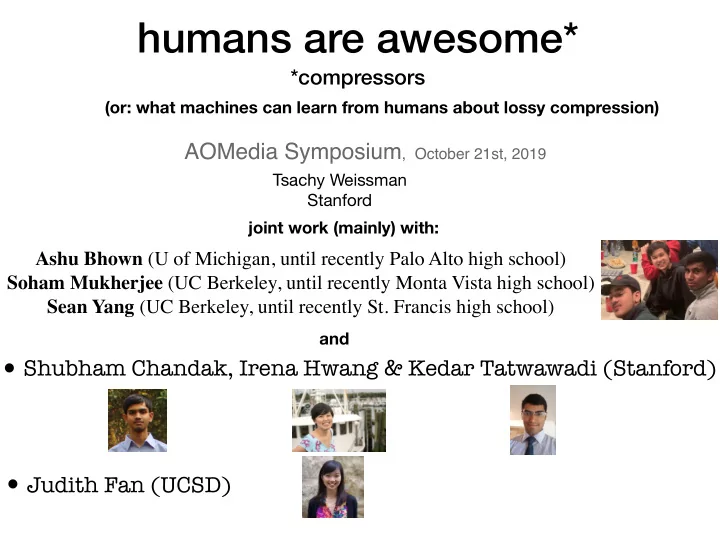

humans are awesome* *compressors (or: what machines can learn from humans about lossy compression) AOMedia Symposium , October 21st, 2019 Tsachy Weissman Stanford joint work (mainly) with: Ashu Bhown (U of Michigan, until recently Palo Alto high school) Soham Mukherjee (UC Berkeley, until recently Monta Vista high school) Sean Yang (UC Berkeley, until recently St. Francis high school) and • Shubham Chandak, Irena Hwang & Kedar Tatwawadi (Stanford) • Judith Fan (UCSD)
image compression • lossless: GIF , PNG • lossy: JPEG, JPEG2000, WebP
should we be happy?
realistic to aim for this kind of a picture? R JPEG X WebP X JPEG X X JPEG2000 X R(D) curve X WebP JPEG JPEG2000 X X WebP D
what would Shannon do?
entropy/compression of English text • can we talk about fundamental limits? • we can talk about achievability
Claude E Shannon, “Prediction and entropy of printed english,” Bell system technical journal, vol. 30, no. 1, pp. 50–64, 1951.
our goals • provide a human centric approach to image compression: • bring humans’ shared language/experiences to bear • utilize humans’ shared knowledge (the Internet) • tailor to what humans care about understand what’s achievable
setup • 2 humans with 2 distinct roles • one is the “describer”, the other the “reconstructor” • describer gets a new image and sends a text describing it to the reconstructor • reconstructor attempts to recreate the image
enter
set-up details • Text Commands (Describer —> Reconstructor) ◦ The describer is only allowed to send messages to the reconstructor through the built-in Skype text chat. ◦ The describer must turn off their outgoing audio/video to avoid inadvertently leaking any information to the reconstructor. • Feedback (Reconstructor —> Describer) ◦ The reconstructor may talk to the describer through audio/video/text chat. ◦ The reconstructor may share their partial reconstruction with the describer in real-time, by using the screen-share feature of Skype. Experiment ends when describer is satisfied with the reconstruction (or wants to call it a day…)
compressed representation bzip2 encoded Skype transcript represents the final compressed representation of the input image
legit? • “feedback” ok • timing?
Testing methodology Evaluating the quality of the reconstruction by the human compressors vs WebP 1. Human compression: The given input image is compressed by the humans using the procedure described. The size (in bytes) of the compressed representation of the image (the text) is recorded. 2. WebP compression: We use the WebP compressor to lossily compress the input image to have a similar size as the human compression text representation. 3. Quality evaluation: We compare the quality of the WebP and human compressed images using human scorers on the Mechanical Turk platform.
What a worker would see:
examples
WebP example I: Original Human Compressed
WebP example ii: Original Human Compressed
WebP example iii: Original Human Compressed
example iv: Human WebP Original Compressed
example v: Human Compressed Original WebP
example vi: Human Compressed Original WebP
Results ➢ Mturk scores for Human and WebP reconstruction
reference • “Towards improved lossy image compression: Human image reconstruction with public-domain images”, Bhown et al., on arXiv • see also “HAAC” website: https://compression.stanford.edu/human-compression
Conclusions thus far ➢ Our experiment shows much room for improvement over existing standards at low bit rate ➢ Effective utilization of semantically and structurally similar images that are publicly available can be key ➢ Humans care about different things (relevant loss function) and also, for humans, it’s often less about fidelity and more about image quality
what next? ➢ HAAC for audio ➢ HAAC for facial images ➢ automated and reproducible HAAC (work in progress)
details: https://compression.stanford.edu/summer-internships-high-school-students
HAAC for music
existing audio compression standards • “lossless”: WAVE (.wav), FLAC (.flac), and APE (.ape) • lossy: MP3 (.mp3) AAC (.mp4, .m4a), OGG (.ogg), and Musepack (.mpc)
how does a human perceive/represent music? • score • lyrics • voice of vocalist(s)
listen ➢ Sweet home Alabama by Lynyrd Skynyrd
some points • humans can perceive and describe music succinctly • garage band can produce reasonable reconstructions based on little (MIDI) • humans often value “quality” over fidelity • humans can produce exquisite reconstructions based on little (the score)
HAAC for facial images ~ ~
toward automated reproducible HAAC
some current/future directions • ML & AI toward fully automated delivery on what we’ve shown is achievable • construction of a good (offline) Side- Information database
HAAC for video?
user defined/specific metrics ?
thank you! questions?
Recommend
More recommend